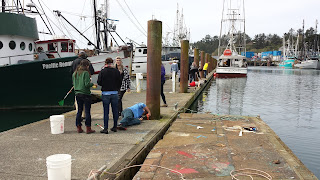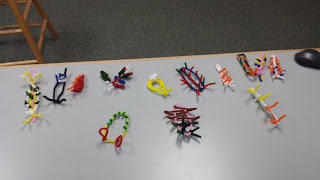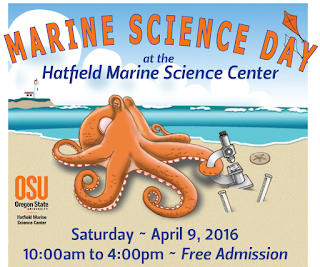Week Two flashed by almost as quickly as
it arrived. Between finishing up lectures/field trips, and preparing for
presentations and our final exams, we rarely had a free moment for anything
other than invertebrates. Not that that is necessarily a bad thing ;).
Our week started out much as it had at the
beginning of the section. Attending lectures and preparing for field trips! On
Monday we learned all about Phylum Arthropoda. Then we talked about a cute
relative of Phylum Arthropoda (and Dr. Hacker’s personal favorite): Phylum Tardigrada,
or the “water bears”. After a short coffee break we came
back to learn about the diverse Phylum Mollusca. We then spent a few hours in
the lab working on our lab notebooks and teaching each other species names for
our lab practicum that was coming up.
Later that afternoon, we had an
interesting lecture on the invasive European green crab, Carcinus maenas, from guest lecturer Dr. Sylvia Yamada. We then
went out into the field to collect traps that she had put out the night before
so that we could record the number, size, and weight of the C. maenas that we caught.
 |
| A number of us down at the low tide zone near HMSC helping Dr. Yamada collect crab traps. |
And now, time for a little bit of local natural history! Amongst our
samples was a female C. maenas that
was VERY pregnant. That large, orange growth in the picture is actually
thousands of eggs. After being fertilized by a male crab, the female carries these eggs for months, before
releasing them into the ocean. Once they hatch, they develop into adorable planktonic larvae, called the zoea stage. After over 2 years of drifting and growing, they settle to the ocean floor to become adult crabs. It was a great night and we learned a lot about
these pesky crustaceans. Thanks Dr. Yamada!

Tuesday began with the lophophorates. This
group covers 3 different phyla with similar characteristics. Then Dr. John
Chapman gave us a short lecture on biological invasions on the Oregon coast. We
learned a lot from him about debris from the devastating tsunami that hit Japan
in 2011 (particularly the dock that floated ashore in April of 2012, pictured to the left). Dr. Chapman does a lot of work with the Japanese marine species that
have hitched rides on this debris and the potential for them invading our
waters. He also spent some time talking about the invasive parasite that is
devastating Yaquina Bay’s population of mud shrimp.
After lectures we all piled
into the vans for one last invertebrate collection trip at the Newport Bayfront
docks. All of us were desperately searching for some elusive ctenophores, but
our efforts went unrewarded. We did manage to collect a few more species for
our studies! Then it was back to the lab to work on identifications and off to
write papers/prepare presentations.
 |
| Collecting samples from the docks at the Newport Bayfront |
When Wednesday came around, I think we
were all starting to feel the pressure of preparing for our exams. We had
papers to write, presentations to prepare for, and species/lectures to
study. We awoke that morning to our last lectures on invertebrates and
immediately dispersed with our respective groups to work on presentations. That
night we held the 11th Annual Marine Invertebrate Presentation and
Dessert Extravaganza. We all gave entertaining presentations
about our favorite marine invertebrates and enjoyed way too many sweets (also
not a bad thing). We started with a Family Feud-inspired game about Velella velella, followed by a cake-pops of Strongylocentrotus
purpuratus, a love story about Pisaster
ochraceus, do-it-yourself nudibranchs, a couple of balloon versions of
anemones, and a nemertean version of Jeopardy. For the last
presentation, we learned about the scheming cuttlefish overlords from Wayne, and even
made our own tin foil hats to protect ourselves from their surveillance (see the first photo of the post). It was
a wonderful evening with plenty of laughs from all, and a great break from our
intense exam studying. After the extravaganza most of us went back to go to
sleep, but a few people hit the library for some late night (read: 3 in the
morning) paper writing.
 |
| |


On Thursday we just had to turn in our
invertebrate papers and then study for the exams. We spent a lot of time in the
lab with Vanessa going over the scientific names of our little critters. I think that
we owe a big thanks to the time that Vanessa spent with us helping us learn all
these species names. Most of the evening was spent on individual studying of
the lecture material for the exam. I
don’t think any of us had seen the apartments so quiet before.
Friday, Exam Day, started out
pretty fantastic. Most of us rolled out of bed early, and Ginger and her
housemates made pancakes for a group study session before the actual exams.
It’s always a good time when we all get together for study and/or food
sessions! After that we hit the library for some last minute cramming before
the dreaded exam finally arrived that afternoon. And then, just like that, the lecture exam
and lab practicum were finished, and we were done. The week ended with an
audible sigh of relief after exams were out of the way (for now), and a few sad
“until next times” with Dr. Hacker and Vanessa. Thanks for a great section!

Even after the section ended, the week
wasn’t over for most of us. This past Saturday, April 9th, was
Marine Science Day here at HMSC, and the few members of our group who didn’t
leave town for the weekend helped out in our lab, showing off our work to the
general public. It was really great being able to teach others, especially all
the young children, about what we do and why it’s important. And, freaking them
out with the annelids we had under the microscope wasn’t a bad time either.
All
in all, we had a very fun week, and we’re all looking forward to what the next
section will bring: Marine Fish.











